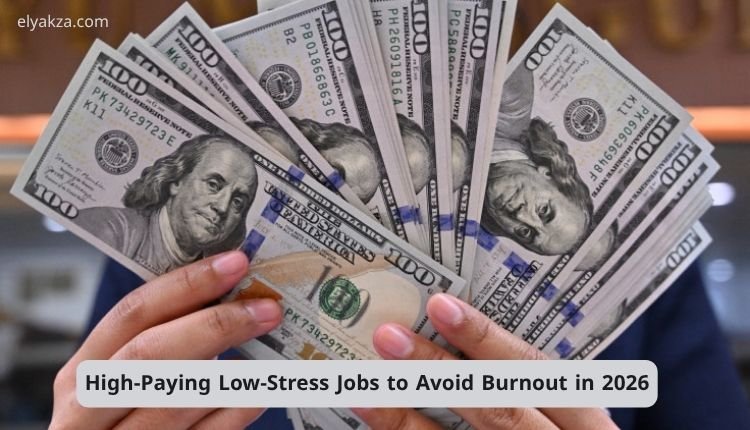Burnout has become one of the most pressing workplace challenges of our era. In the United States, surveys reveal that more than one-third of employees feel burned out on the job, with consequences ranging from daily fatigue and anxiety to serious health problems and declining job satisfaction. In fact, 77% of professionals say their work negatively impacts their personal life.
قائمة المحتويات
This growing issue has pushed many people to rethink their career paths. Today, professionals are seeking not only high-paying opportunities but also careers that protect mental health, offer flexibility, and allow for sustainable growth. The good news is that such jobs exist—fields where compensation is competitive, demand is rising, and stress levels remain relatively low.
In this article, we’ll explore 10 high-paying low-stress jobs in 2025 that allow you to achieve financial security without sacrificing your well-being. We’ll also cover what makes a job “low-stress,” the benefits of pursuing such a career, and tips for thriving in these roles long-term.
What Makes a Job Low-Stress?
Stress is subjective—what overwhelms one person may energize another. Still, researchers and career experts agree on several factors that consistently influence workplace stress levels. Low-stress jobs are typically those that minimize pressure while maximizing clarity, autonomy, and balance.
Key Characteristics of Low-Stress Careers
- Reasonable Workloads: Deadlines and deliverables are manageable instead of overwhelming.
- Autonomy and Control: Employees can organize their schedules and prioritize tasks without excessive micromanagement.
- Supportive Environments: Healthy communication, recognition, and constructive feedback replace toxic competition.
- Work-Life Balance: Hours are predictable, leaving time for family, hobbies, and personal growth.
- Limited Hazards: Jobs don’t regularly involve physical danger or high-stakes emergencies.
- Clear Expectations: Roles and responsibilities are well-defined, reducing uncertainty.
- Opportunities for Growth: Career development exists without requiring constant high-stress sacrifices.
By meeting these criteria, a career can deliver the double benefit of strong financial rewards and a sustainable lifestyle.
The Benefits of Choosing a Low-Stress Career
Before diving into the list of high-paying low-stress jobs for 2025, it’s worth considering why this balance matters so much.
- Better Physical Health – Chronic stress contributes to high blood pressure, insomnia, weakened immunity, and even cardiovascular disease. A low-stress job reduces these risks significantly.
- Improved Mental Health – Roles that offer flexibility and autonomy minimize anxiety and depression associated with overwork.
- Increased Productivity – Employees in calmer environments often produce higher-quality work because they can focus without constant pressure.
- Stronger Career Longevity – Avoiding burnout means you’re more likely to sustain performance and advance over time.
- Work-Life Satisfaction – Low-stress jobs give you the energy to pursue passions, nurture relationships, and enjoy life outside of work.
Now, let’s explore the 10 careers that combine high salaries with low stress in 2025.
10 High-Paying Low-Stress Jobs in 2025
1. Data Scientist

- Average U.S. Salary (2025): $108,020
- Job Outlook (2022–2032): 35% growth
Data scientists are among the most in-demand professionals in the modern economy. They collect, analyze, and interpret complex datasets to uncover insights that inform business strategies, scientific research, or technological innovation.
Why It’s Low-Stress:
- Data scientists often work independently or in small teams with flexible schedules.
- Many positions offer remote or hybrid arrangements.
- Clear project goals and measurable outcomes minimize ambiguity.
Skills Required: Strong background in statistics, machine learning, Python or R programming, and data visualization.
Career Path: Typically requires a bachelor’s in computer science, statistics, or mathematics, with many professionals advancing through master’s or Ph.D. programs.
2. Orthodontist
- Average U.S. Salary (2025): $239,200
- Job Outlook (2022–2032): 4% growth
Orthodontists specialize in diagnosing and treating misaligned teeth and jaw issues. While the educational path is lengthy—10+ years including dental school and residency—the payoff is among the highest in healthcare.
Why It’s Low-Stress:
- Work focuses on non-emergency, non-life-threatening conditions.
- Standard business hours with predictable schedules.
- Positive patient interactions often result in long-term treatment relationships.
Skills Required: Precision in dental procedures, strong patient communication, and expertise in orthodontic devices and technology.
Career Path: Requires a dental degree (DDS or DMD) plus additional specialized orthodontic training.
3. Materials Scientist

- Average U.S. Salary (2025): $106,160
- Job Outlook (2022–2032): 6% growth
Materials scientists study chemical properties and develop new materials used in industries like aerospace, electronics, and medicine.
Why It’s Low-Stress:
- Research-oriented work allows for deep focus without constant deadlines.
- Balanced combination of lab experiments and theoretical problem-solving.
- Intellectual engagement provides stimulation without excessive pressure.
Skills Required: Chemistry, physics, lab management, and innovation-driven thinking.
Career Path: A bachelor’s degree in materials science or chemistry, often followed by graduate study.
4. Curator
- Average U.S. Salary (2025): $57,120
- Job Outlook (2022–2032): 10% growth
Curators oversee museum collections, exhibitions, and cultural projects. They negotiate acquisitions, manage preservation, and bring history or art to the public.
Why It’s Low-Stress:
- Work is creative and meaningful, fostering a sense of cultural contribution.
- Museums provide calm, reflective environments.
- Responsibilities are steady rather than crisis-driven.
Skills Required: Art or history expertise, research skills, organizational ability, and fundraising knowledge.
Career Path: Typically requires a master’s in museum studies, art history, or archaeology.
5. Web Developer
- Average U.S. Salary (2025): $92,750
- Job Outlook (2022–2032): 16% growth
Web developers design and build websites or apps, working with both front-end (design) and back-end (functionality) systems.
Why It’s Low-Stress:
- Flexible schedules and abundant freelance opportunities.
- Clear project-based work with defined deliverables.
- Many roles are fully remote.
Skills Required: HTML, CSS, JavaScript, frameworks like React or Angular, and problem-solving abilities.
Career Path: A bachelor’s degree helps, but many successful developers are self-taught or trained through coding bootcamps.

6. Audiologist
- Average U.S. Salary (2025): $87,740
- Job Outlook (2022–2032): 11% growth
Audiologists diagnose and treat hearing loss and balance disorders. Their work spans hospitals, schools, and private clinics.
Why It’s Low-Stress:
- Focuses on non-emergency conditions.
- Standard working hours with minimal on-call duties.
- Strong reliance on diagnostic technology.
Skills Required: Audiology expertise, patient care, and familiarity with hearing-assistive devices.
Career Path: Requires a doctoral degree in audiology (Au.D.) and state licensure.
7. Chemical Engineer
- Average U.S. Salary (2025): $112,100
- Job Outlook (2022–2032): 8% growth
Chemical engineers design processes to produce food, drugs, fuel, and industrial materials.
Why It’s Low-Stress:
- Structured projects with clear technical goals.
- Blend of lab research and engineering design.
- Collaborative work without constant emergencies.
Skills Required: Chemistry, mathematics, process design, and engineering software.
Career Path: Requires a bachelor’s degree in chemical engineering, with opportunities for advancement into leadership roles.
8. Mathematician
- Average U.S. Salary (2025): $104,860
- Job Outlook (2022–2032): 30% growth
Mathematicians apply theories and formulas to solve real-world problems in fields such as cryptography, finance, and robotics.
Why It’s Low-Stress:
- Independent work in calm office environments.
- Focus on problem-solving without urgent deadlines.
- High demand across industries, providing job security.
Skills Required: Abstract thinking, advanced mathematics, logical reasoning, and communication of findings.
Career Path: A master’s or Ph.D. in mathematics or applied fields like statistics or data science.
9. Astronomer
- Average U.S. Salary (2025): $127,930
- Job Outlook (2022–2032): 5% growth
Astronomers study planets, galaxies, and cosmic phenomena, often conducting research at observatories or universities.
Why It’s Low-Stress:
- Research-driven work at a steady pace.
- Fascinating subject matter keeps engagement high.
- Limited exposure to urgent, stressful situations.
Skills Required: Physics, astronomy, programming, and observational techniques.
Career Path: Requires a Ph.D. in astronomy or astrophysics.
“Read Also: مصفاة الذهب في مصر“
10. Technical Writer
- Average U.S. Salary (2025): $80,050
- Job Outlook (2022–2032): 7% growth
Technical writers simplify complex topics into clear guides, manuals, and documentation for businesses and consumers.
Why It’s Low-Stress:
- Flexible work options with predictable deadlines.
- Creative balance between writing and technical explanation.
- High demand in industries like software, healthcare, and engineering.
Skills Required: Strong writing ability, subject-matter knowledge, and communication skills.
Career Path: Typically requires a degree in English, communications, or a technical field.
“Read Also: مؤشرات الاقتصاد المصري“
Tips to Thrive in a Low-Stress Career
Landing one of these jobs is only the first step. To ensure your career remains rewarding and sustainable, consider the following strategies:
- Set Boundaries: Even in low-stress roles, overcommitting can create unnecessary strain.
- Prioritize Wellness: Incorporate regular exercise, sleep, and mindfulness practices into your routine.
- Keep Learning: Continual skill development helps you stay competitive without pressure.
- Seek Supportive Employers: A healthy organizational culture is just as important as the role itself.
- Balance Ambition with Realism: Aim for growth, but not at the cost of mental health.
“Read Also: إزاي تكسب 100 مليون دولار“
Balancing Salary, Passion, and Well-Being
Choosing a career isn’t just about the paycheck or prestige—it’s about aligning your strengths, passions, and lifestyle with a role that enhances rather than drains your energy. While these high-paying low-stress jobs offer excellent opportunities in 2025, the right choice depends on your personal triggers, interests, and values.
Remember, success isn’t defined solely by climbing the corporate ladder—it’s also about building a career that protects your health, supports your life goals, and provides a sense of fulfillment.
High-Paying Low-Stress Jobs : Conclusion
Burnout doesn’t have to be the price of success. With the rise of remote work, flexible scheduling, and growing demand in fields ranging from data science to healthcare, professionals in 2025 have more options than ever to secure high-paying low-stress jobs.
By choosing wisely, you can enjoy the best of both worlds: strong financial stability and a sustainable work-life balance. The future of work is not about enduring endless stress—it’s about thriving in careers that support long-term well-being.
يتميز أحمد فتحي بكونه كاتبًا اقتصاديًا يعتمد على تبسيط المفاهيم الاقتصادية المعقدة وربطها بالأحداث اليومية التي تهم القارئ. يكتب بشكل احترافي عن النظريات الاقتصادية، الأسواق المالية، السياسات النقدية والمالية، مع تحليل معمق للأخبار والتقارير الاقتصادية العالمية والمحلية.
من خلال خبرته، يقدم أحمد فتحي محتوى يساعد القراء على فهم حركة الاقتصاد وتأثيرها المباشر على حياتهم اليومية، مثل التضخم، أسعار الفائدة، والتجارة الدولية. أسلوبه يجمع بين الدقة الأكاديمية والطرح السلس، مما يجعله مصدرًا موثوقًا للمهتمين بعالم الاقتصاد وصناع القرار على حد سواء.

